
 |
Eager Space | Videos by Alpha | Videos by Date | All Video Text | Support | Community | About |
|---|

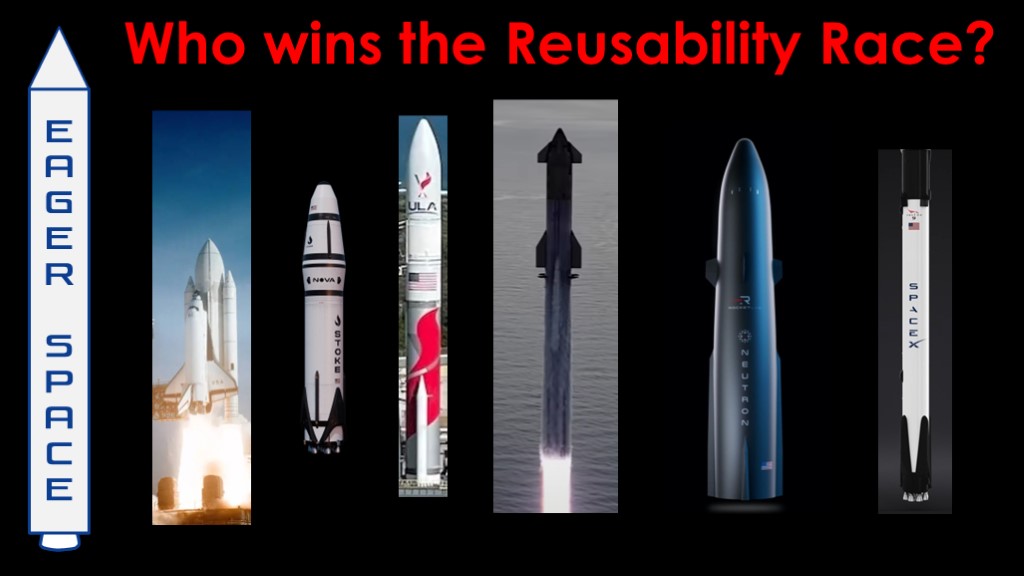
Sloth in Spacesuit
https://www.etsy.com/listing/867583192/space-sloth-astronaut-and-saturn-art
The story of Vulcan
https://www.youtube.com/watch?v=fQ3PIW3cqKc
The real secrets of rocket design revealed:
https://www.youtube.com/watch?v=iIULRMRcyZM
Satellite ground track visualizer:
https://observablehq.com/@jake-low/satellite-ground-track-visualizer
How SpaceX might have failed:
https://www.youtube.com/watch?v=c0Gnn2WPgUI
Starship Booster Droneship Catch?
https://www.youtube.com/watch?v=7yC86I0rL0o
Blue Origin's Starship Killer?
https://www.youtube.com/watch?v=Y-SY9hJtIYY
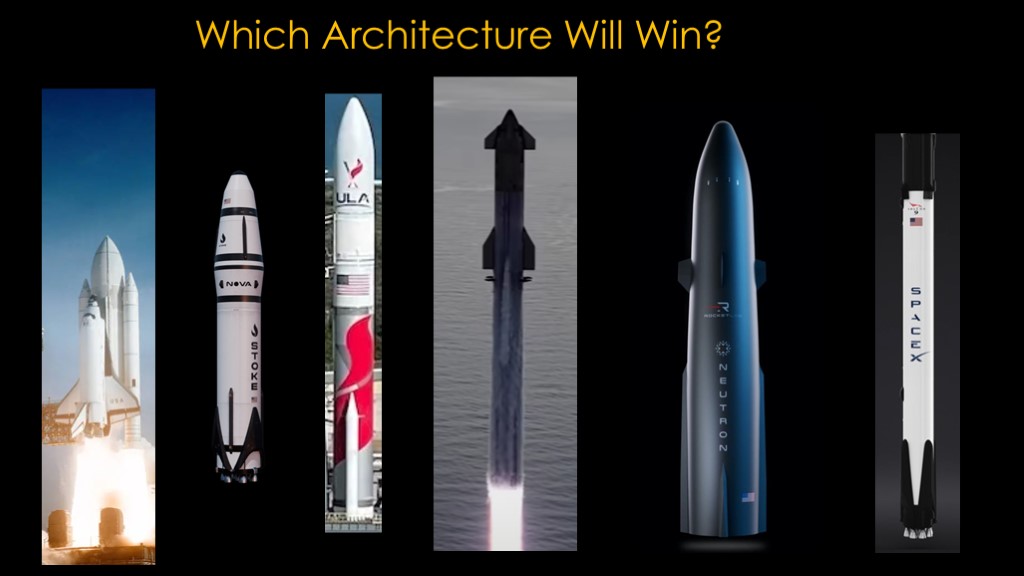
There are a number of different organizations developing reusable rockets - some partially reusable, some fully reusable.
Which ones are going to be the winners? Is there a way we can analyze them to get some insight into that question?
We are going to be exploring the differences between architectures and the effect those differences have on costs.
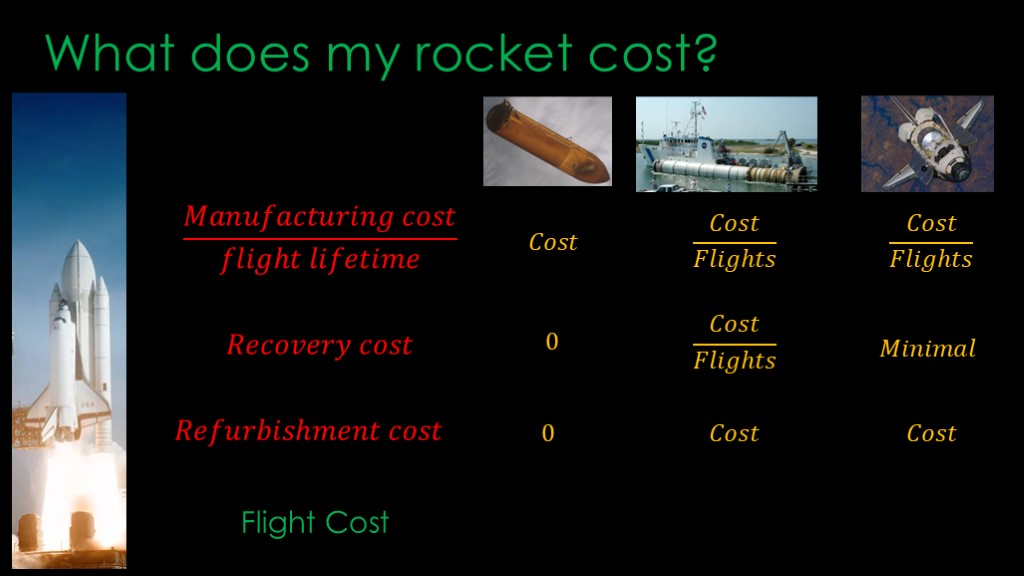
As an example of a partially reusable system, we're going to look at shuttle.
The cost of flying a rocket component is the manufacturing cost divided by the number of flights we can reuse it.
There is the recovery cost for the reusable part - how much it costs to get it back to the location where you can reuse it.
And there is the refurbishment cost - how much it costs to inspect and repair the component for the next flight.
Add those up to get the flight cost, sometimes called the incremental cost - how much more it would cost to fly one more time. It ignores all the fixed costs of running a rocket company.
Shuttle is interesting because it presents three different kinds of components.
The external tank is a traditional rocket component that is expended, so you pay the full manufacturing cost every flight and there is no recovery or refurbishment cost.
The solid rocket boosters were reused, so their manufacturing cost is the cost divided by the number of flights. They were recovered at sea, so the cost is *mostly* the cost of the marine assets used to recover them divided by the number of flights. The refurbishment cost is what it took to take the booster apart into segments and ship them back to Utah plus the inspection and repair costs there.
The solids were successfully reused but because the segments are just big steel tubes the cost to recover them, ship them back to Utah, and requalify them for flight was pretty much the same as the cost of new segments.
The shuttle orbiter was reusable, so the construction cost - hard to nail down but $1 billion is in the right ballpark - is spread across an average of 27 flights for the 5 orbiters built, so a little under $40 million per flight. I'm going to call the recovery cost minimal since it didn't have any expensive marine assets, though there was a dedicated 747 to fly it home when it had to land in California because of weather. And there was a refurbishment cost before it could fly again, which was very high for shuttle - it's better to call the process "remanufacturing" rather than refurbishment.
Recovery and refurbishment costs are difficult to predict ahead of time, which means a reusable system has much more uncertainty in cost per flight and that's what came back to bite NASA for shuttle; rebuilding the orbiter and engines after every flight was just too expensive.
The lesson of shuttle and reusability was one reason the traditional space companies didn't develop reusable rockets; the cost predictability makes expendables a safer bet.
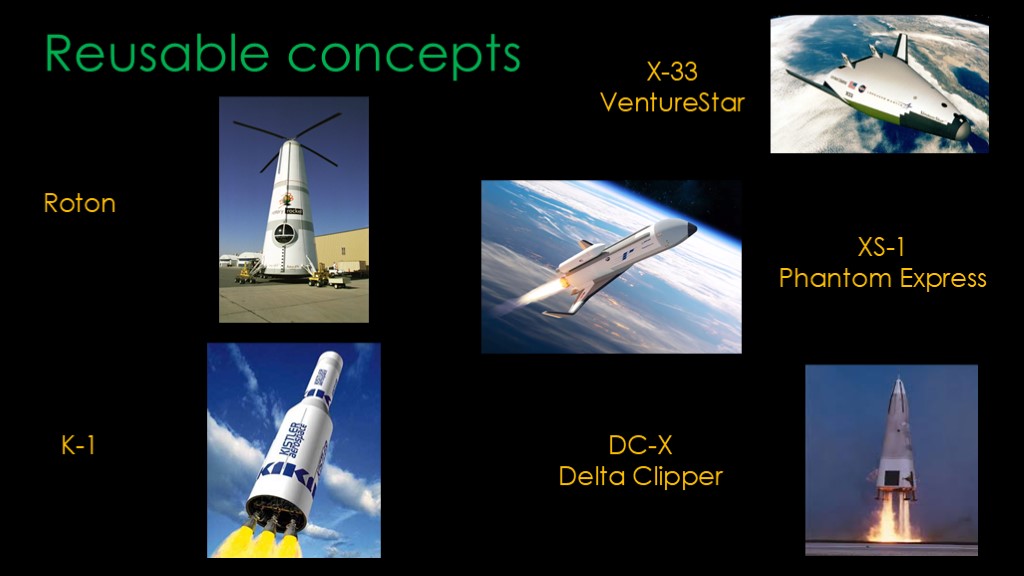
There were some companies that tried...
Rotary rocket had the Roton single stage to orbit vehicle, which I'm not going to try to describe. Wikipedia has a good article on it.
Kistler had the K-1, a two-stage fully reusable vehicle. Kistler was originally selected along with SpaceX to fly cargo to ISS, but they could not meet the funding requirements and were dropped from the program.
There wasn't really anyone else...
My guess is that some of you are complaining. What about the X-33 venturestar, the XS-1 phantom express, or the DC-X Delta Clipper. Those were all programs with reusable aspirations, but the real aspirations of Lockheed Martin, Boeing, and McDonnell Douglass were to maximize the amount of government money received for the least amount of work.
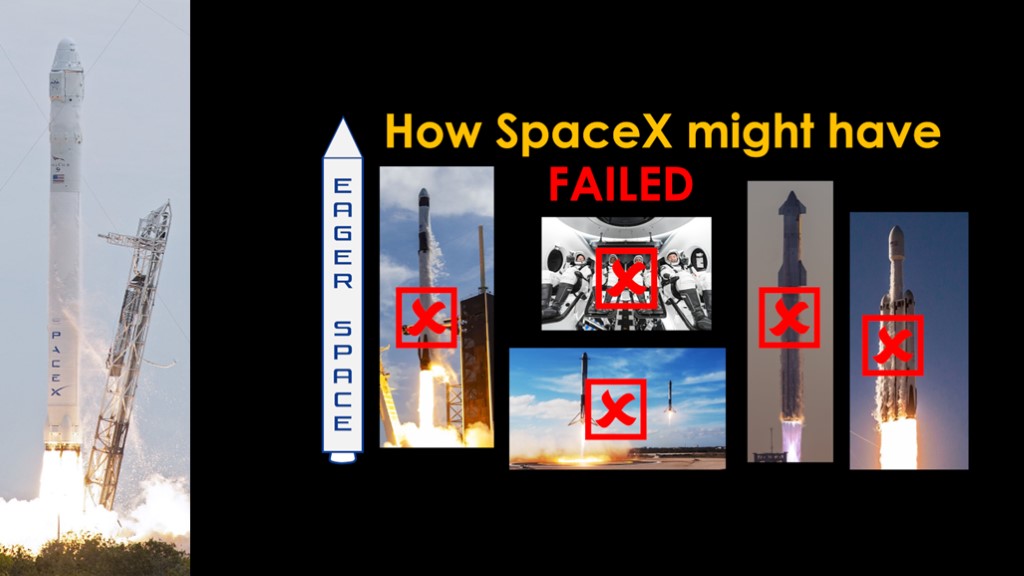
And then SpaceX came in with a solid technical organization and impeccable timing and leveraged a NASA contract into a conservative medium launcher for the cargo dragon capsule.
I talk about a number of places where SpaceX might have never gotten beyond Falcon 1 in my video "How SpaceX might have failed", but they were successful and then went on to retrofit booster reuse to the rocket they were already flying...

We can use the same model we used for shuttle for Falcon 9 costs, applying it to the booster and second stage.
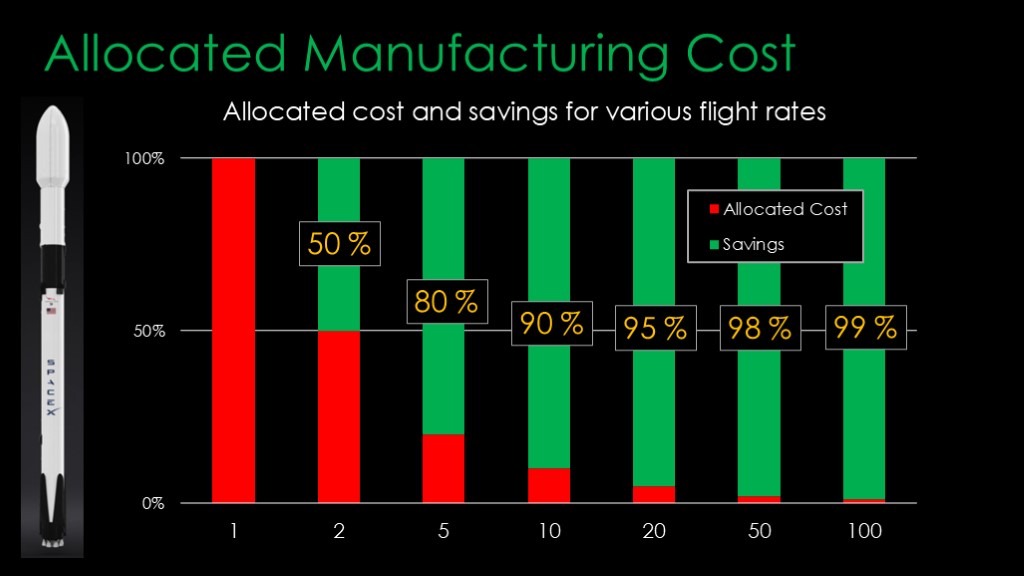
We can understand what I call allocated manufacturing cost - the cost that we allocate to each flight- using this chart. The green shows the percentage of cost savings for each flight rate.
If we fly twice, we save 50% of the cost, and by the time we get to 10 flights, we have saved 90% of the cost. The savings increase as we fly more, but they are small increases after 20 flights.
The point is that with a reusable component, the allocated manufacturing cost goes down quickly, and if you can hit even 10 reuses, it's not a major factor in a partially reusable system like Falcon 9. You should look elsewhere for additional savings.

Space-offshore.com is a great resource for information about the marine assets used by rocket companies. SpaceX has autonomous droneships for landings and ships that support landing missions and retrieve fairings.
The problem is that ships cost a lot of money even tied up to the dock; you need to pay for crew, dock fees, etc., and you therefore have large fixed costs. If you fly 5 flights a year, you can divide that cost by 5 to figure out your allocated fixed cost before you add in the cost of fuel and - if you are SpaceX - the cost to charter tugboats to move the drone ships around.
This is why Rocket Lab CEO Peter Beck once said, "Marine assets suck".
If you can fly 40 flights a year using one set of marine assets - which is about where SpaceX is now - then it's obviously a lot cheaper, but beware models that require high flight rates to be economically viable. There be monsters there.
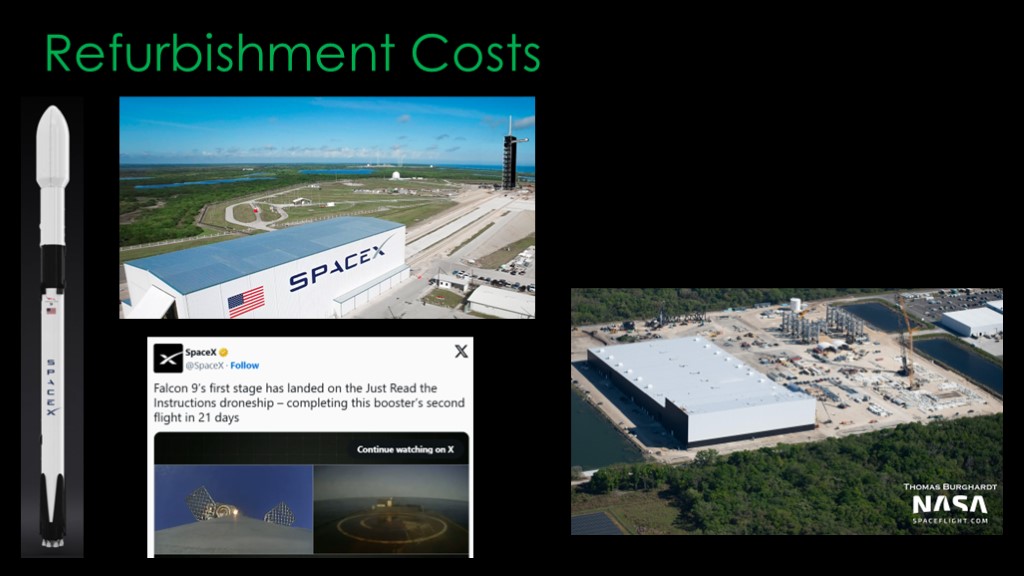
The final category is refurbishment costs. The cost to refurbish a Falcon 9 is proprietary to SpaceX and I haven't seen any numbers released, and therefore we are forced to engage in a bit of conjecture.
I don't think that they are particularly high because SpaceX has a small footprint in Florida; they have buildings at their two launch pads and the Roberts Road building at Kennedy Space Center shown on the right that they built to support their higher flight rate.
There are those who say that the slow turnaround on boosters - never approaching Musk's stated goal of 24 hours - is an indication that there is a lot of refurbishment required.
I disagree.
SpaceX has around a dozen boosters in their current fleet, which means that if they fly 120 missions in a year they will fly each booster about 10 times. They could *theoretically* support that launch rate with only 6 boosters, but it would make their recovery operations harder and if they lost one it would be much more impactful. Far better to keep a few more around and just use them less often.
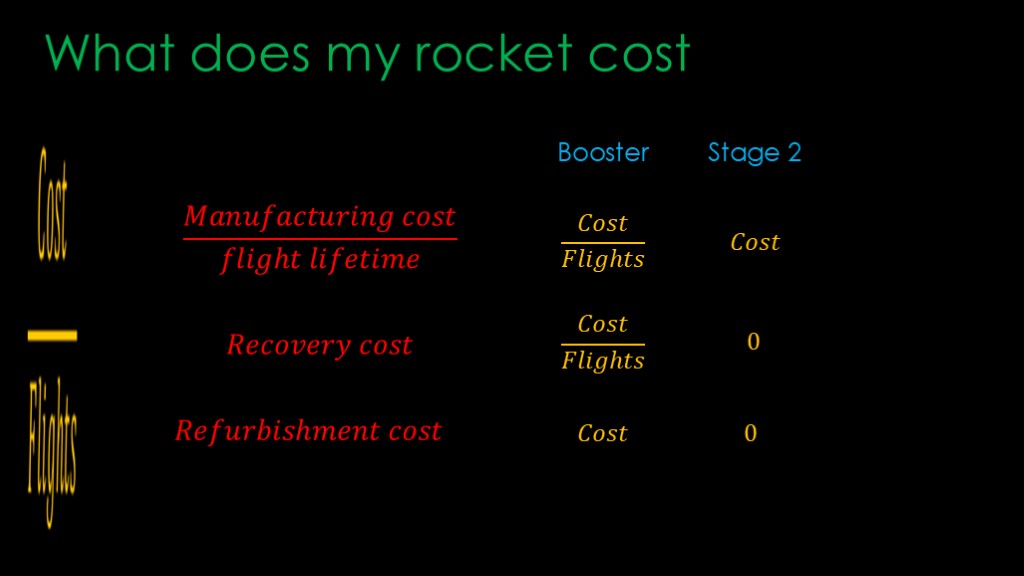
Those were the booster costs, and the second stage costs are just the cost of the stage.
Assuming that you can build a rocket with low refurbishment costs, the big drivers for the overall cost are the recovery cost and the cost of the second stage. If we want to optimize our system for low prices, those are the two big levers, with the second stage being more important as its less dependent on flight rate.
Who is trying to develop a partially reusable rocket?
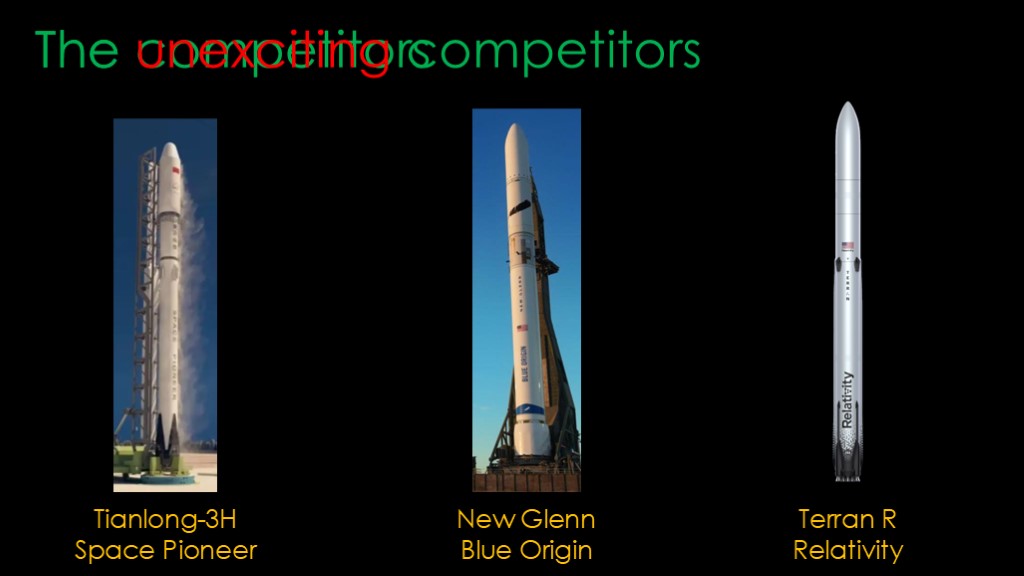
There are a number of possible competitors to Falcon 9.
Tianlong-3H from China's space pioneer, along with other Chinese rockets. They won't be a competitor for US launches and other countries that wouldn't fly China, but it could be attractive to some countries and definitely would be very useful for China's internal space program.
New Glenn from Blue Origin and Terran R from Relativity are next. They might be able to avoid SpaceX by selling in the "Anybody but SpaceX" market, currently the Amazon Kuiper launches.
Having said that, they aren't going to be competitive with SpaceX head to head. SpaceX has been landing boosters for 8 years and has spent those years optimizing as much as they can, they are flying over 100 times a year, and they have locked up lucrative contracts with NASA and the DoD.
These competitors are all designing traditional cylindrical rockets to emulate the way Falcon 9 works, and I've therefore decided to label them the unexciting competitors. They might compete, but I don't expect them to have a big impact.
There are two launchers worth an extra look.
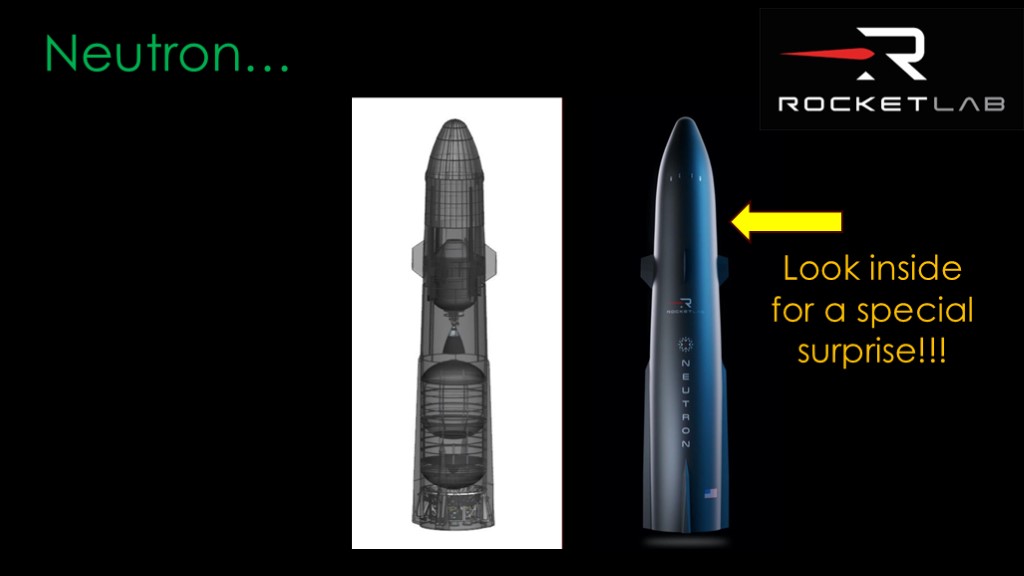
The first is RocketLab's Neutron.
Rocket Lab has taken a unique approach. Instead of stacking the second stage on top of the booster, they place the second stage inside of the booster.
There are three big advantages of this design...
The first advantage is that the second stage is protected from aerodynamic forces so that it can be unaerodynamic if that is the best design.
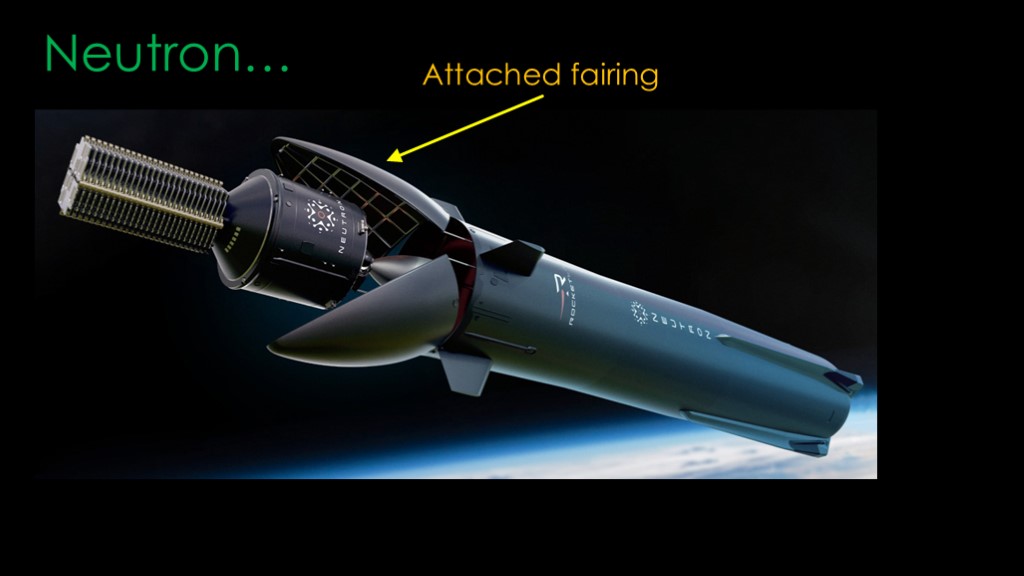
The second is that the payload fairing that protects the second stage and payload is permanently attached to the booster.
If you don't need to recover fairings separately, that simplifies recovery logistics. It also keeps the fairings dry for easier refurbishment, unlike the Falcon 9 approach.
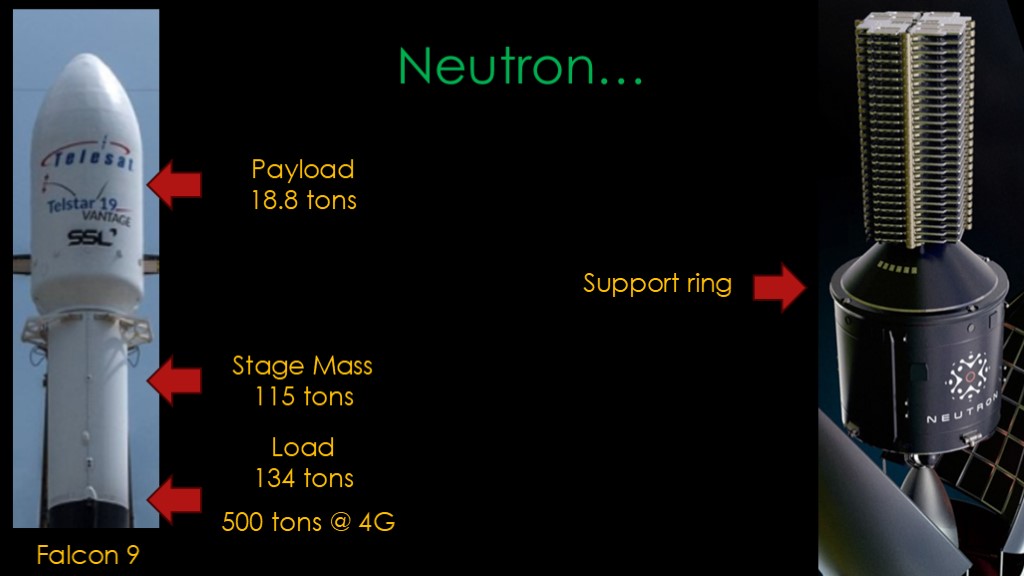
The third advantage is a bit subtle. Like most rockets, Falcon 9 carries the mass of the payload at the top of the second stage. The maximum mass is about 18.8 tons, and that's set on top of a second stage mass of about 115 tons, so the bottom of the second stage that sits on top of the booster has to carry a static load of about 134 tons. But it's a lot worse than that; the booster gets close to 4 Gs of acceleration, so the bottom of the stage has to deal with about 500 tons of load.
That requires a fairly beefy second stage structure.
The Neutron payload adapter that attaches the payload to the second stage has a bottom diameter bigger than the second stage. The part I'm calling the support ring can therefore sit on the booster structure. That means that the second stage doesn't need to support the weight of the payload during the booster part of the launch. The second stage is hung from that support ring, which means the structure of the stage is under tension - being pulled down - rather than being under compression - being pushed up from underneath, and the carbon fiber that is used in Neutron is much stronger under tension than under compression.
Both of these mean that the second stage can be lighter.
It's this sort of design that makes me unexcited about the other companies that are mostly building Falcon 9 clones. Rocket Lab is leveraging their deep experience with carbon fiber to create an architecture better than Falcon 9.
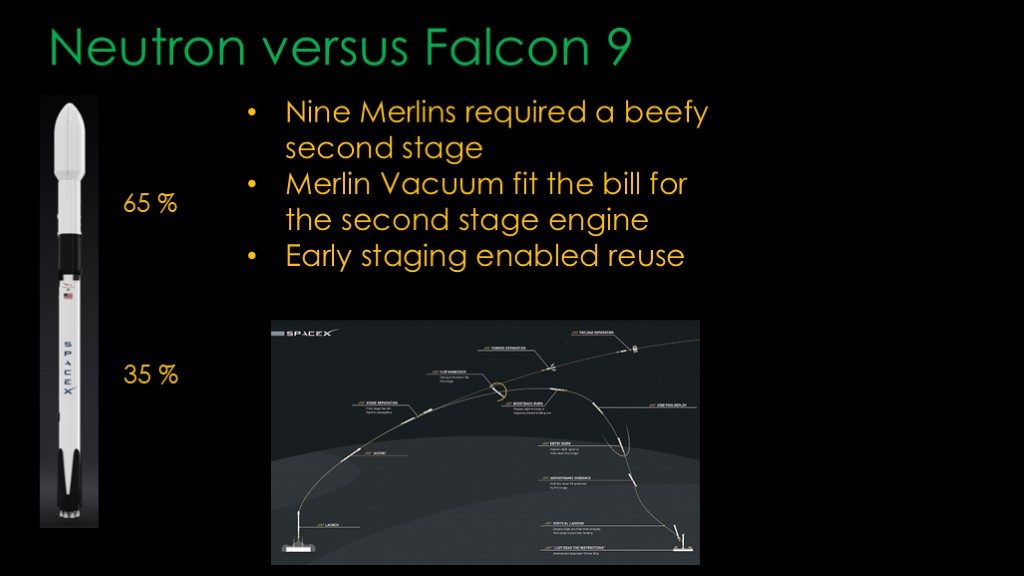
Falcon 9 has a big beefy second stage and a relatively weak booster, with roughly 65% of the work to get to orbit done by the second stage and only about 35% done by the booster. There were a few reasons for this.
The first is that nine merlin engines was already silly in rocket terms, so to get the payload performance they needed, they would need a beefy second stage.
The second was that a merlin vacuum engine was the right thrust for that beefy second stage, so the overall design made sense.
And the third was that the early staging that came with this architecture meant that the booster was low and travelling slowly for a booster, and that made the possible reuse a lot easier to develop.
The main requirement for Falcon 9 was to meet the NASA commercial resupply contract and start flying quickly, and that's a big reason why it is based on the existing Merlin engine.
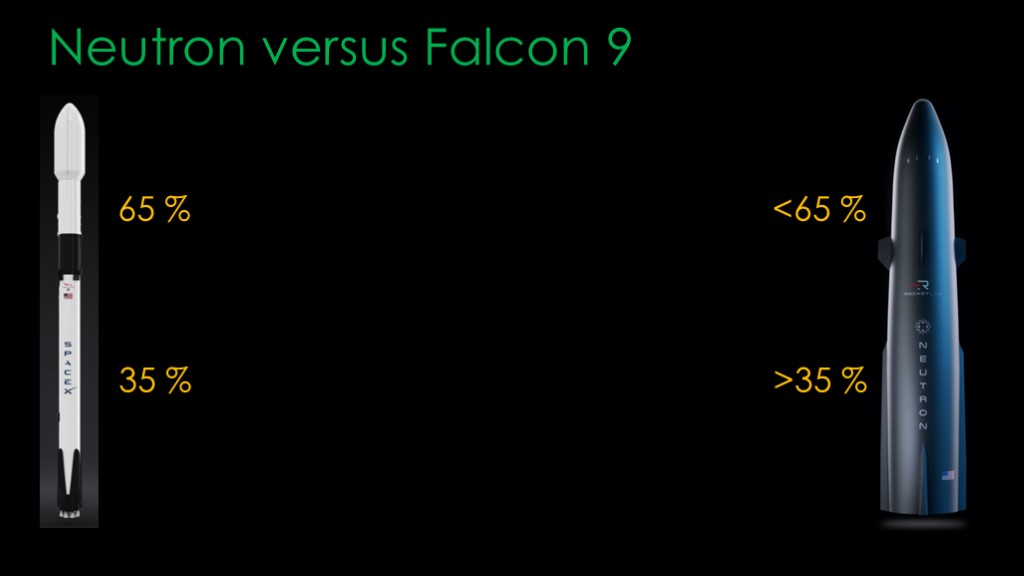
Neutron is a different beast, however, and doesn't have the same constraints - it's closer to what would be called a "clean sheet" design in engineering.
We know that Neutron is trying to build a lighter and cheaper second stage, and another way to get there is to have the booster do more work and the second stage do less work.
Can they stage higher and faster - putting more of the work on the reusable booster - and downsize the second stage even further?
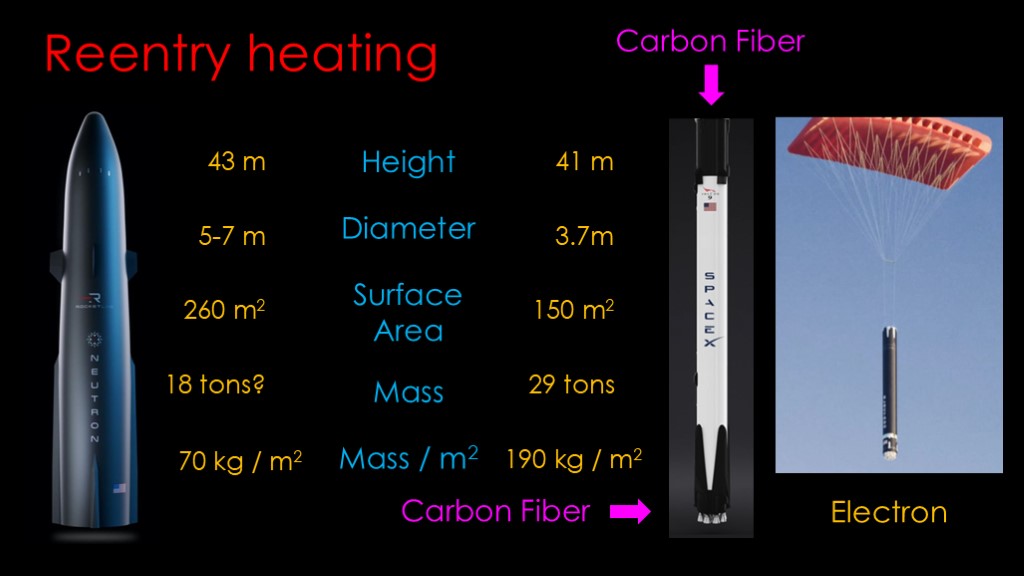
One barrier to doing that will be reentry heating; to be reused the Neutron booster obviously needs to be undamaged during reentry.
Rocket lab has already recovered the booster of their electron rocket, which is also made from carbon fiber, and Electron stages at a similar altitude and velocity to Falcon 9, so carbon fiber doesn't appear to be a significant barrier to booster reuse.
If we compare the Neutron and Falcon 9 boosters, they are nearly identical in height, but the diameter of the neutron is nearly double and therefore it has a surface area about 73% larger than Falcon 9.
The mass of the Falcon 9 stage empty is about 29 tons, and I'm going to guess that the empty neutron is going to be about 18 tons. That means the energy to be dissipated for the Neutron booster is only about 60% of energy that the Falcon 9 needs to get rid of.
If we calculate the mass per square meter of surface area, it's 70 kg per square meter for neutron versus 190 kg per square meter for Falcon 9.
This means that Neutron is a lot "floatier" - with less mass and more surface area it's going to slow down much quicker than Falcon 9. That should keep the heating load down considerably compared to Falcon 9.
Oh, and that Falcon 9 rocket?
The black interstage that protects the second stage engine is made out of carbon fiber on top of aluminum honeycomb, and it survives fine. As do the landing legs, also made out of carbon fiber.
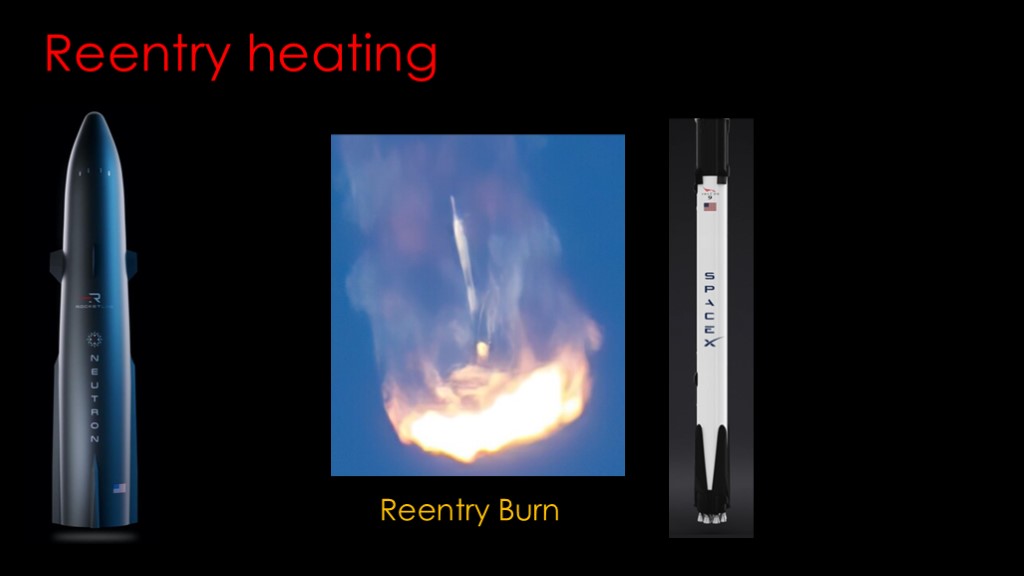
It gets a bit more complicated...
Falcon 9 uses a reentry burn to slow the booster down and therefore reduce the amount of heating it must resist. Neutron is planning on skipping the reentry burn to avoid the propellant use and therefore increase the payload. Being floaty should enable that, but is there additional margin that would allow them to stage later?
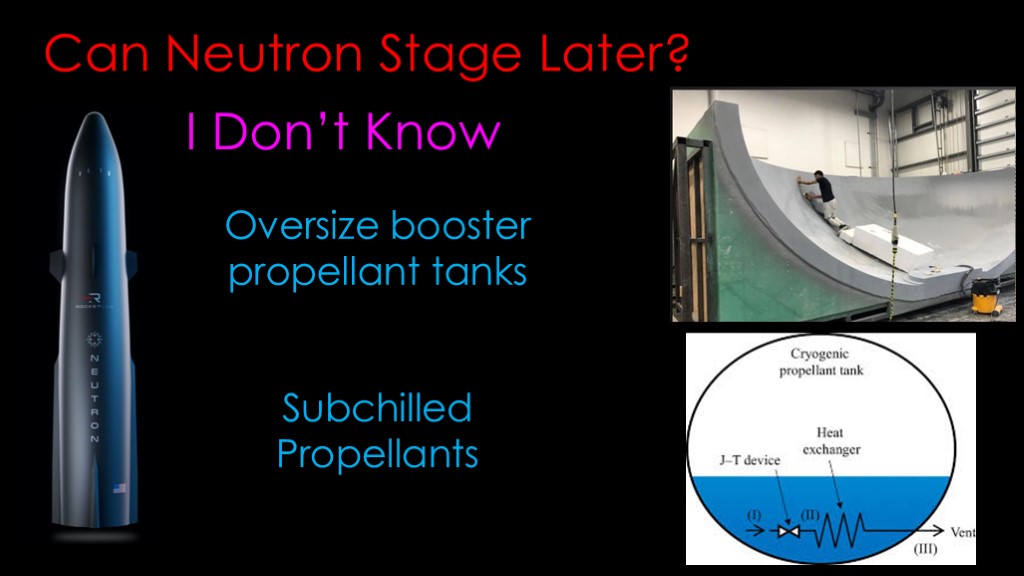
If you ask whether neutron will stage later than Falcon 9, I can only give my usual answer, which is "I don't know". And I'm not sure rocket lab knows - this may be something that you can only learn by flying.
Rocket lab needs to be flying payloads on Neutron quickly - the same position that SpaceX was in when they built Falcon 9 - and therefore they will likely be conservative in choosing a staging point. They have the added issue that carbon fiber rockets require carbon fiber molds, and that makes it slow to experiment - they can't just add rings to an existing Starship design - especially with the complex shape of the neutron booster.
I see two opportunities, however, for them to get more oomph from the booster so that they can downsize the second stage.
They could make the booster propellant tanks slightly oversize from their initial estimate and underfill them to get their initial staging time, and then add more propellant if their flight data shows they can stage later.
Or they could do what SpaceX has done and move to subchilled propellants, which allows you to stuff more propellant in the same tanks.
That would enable them to simplify and lighten the second stage, reducing the cost per flight, though it would likely require some new molds for the second stage and the cost savings probably isn't great.
I expect they would use higher booster performance for the traditional use, which is to increase payload to orbit. That will be more valuable than a slight reduction in second stage cost.
There *is* a partially reusable rocket that plans to stage much later, and that's the second one to discuss.
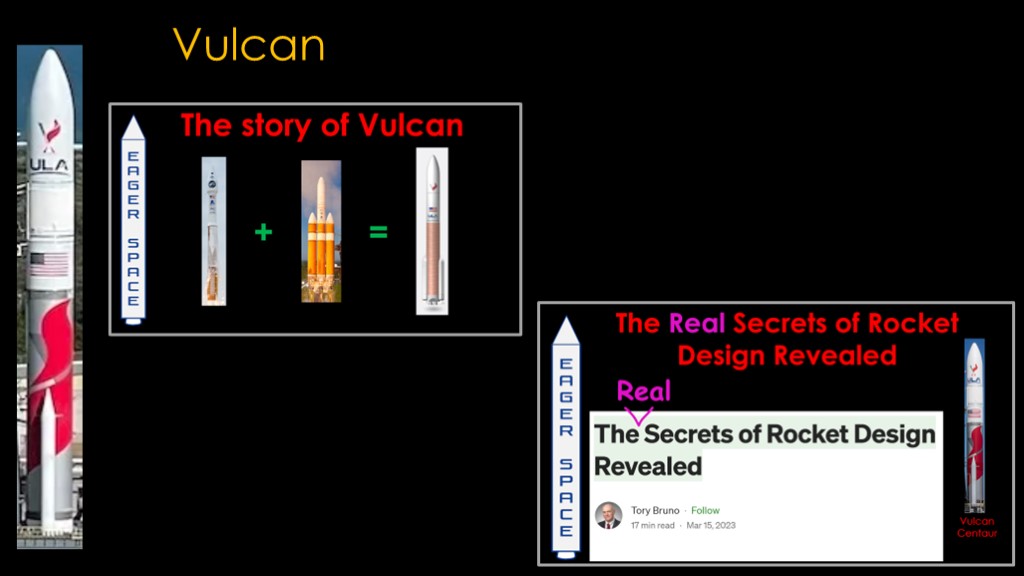
That rocket is ULA's Vulcan.
I've talked about the Vulcan reuse architecture in the past in the story of Vulcan and the real secrets of rocket design revealed, so this will be a bit of an overview.
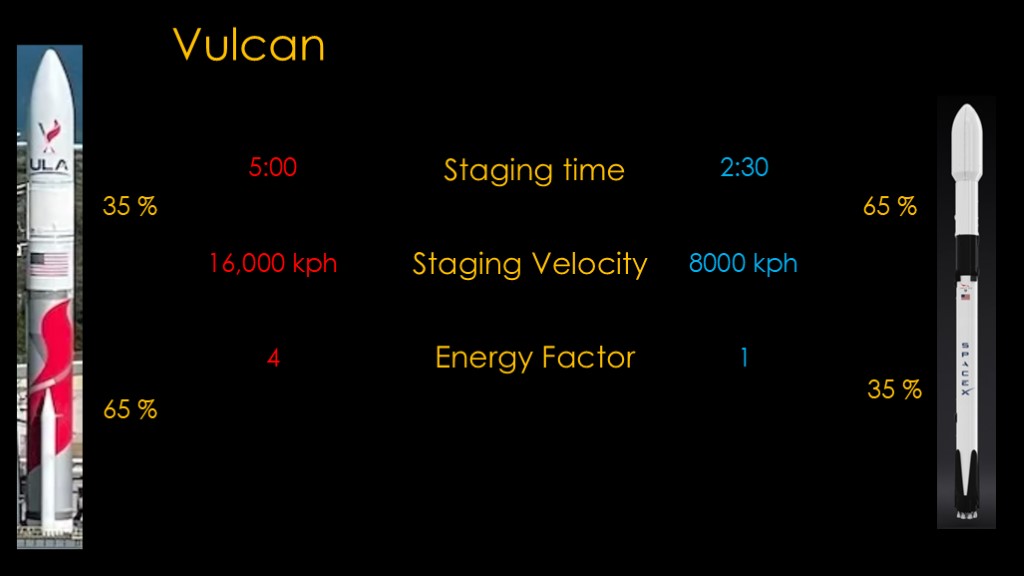
I don't have exact numbers on Vulcan, but we do know that the Vulcan booster burns for about 5 minutes which is a bit more than the Atlas V booster and roughly double the Falcon 9. Vulcan *roughly* flips the ratio between the first and second stage from what Falcon 9 does, with the booster and solid rocket boosters providing 65% of the energy and the Centaur V upper stage only providing 35% of the energy.
That is exactly what you want for partial reusability - you want a cheap second stage that doesn't have to do a lot of work.
But there's a problem...
The Falcon 9 booster is travelling at about 8000 kph at staging, or about 30% of orbital velocity, while, the Vulcan booster is travelling at about 16,000 kph, or 60% of orbital velocity.
In terms of energy, it's worse because the kinetic energy of the booster is proportional to the square of the velocity, so Vulcan is carrying about 4 times the energy of Falcon 9.
This makes adopting the Falcon 9 approach for Vulcan impractical; the booster is simply moving far to fast to survive reentry.
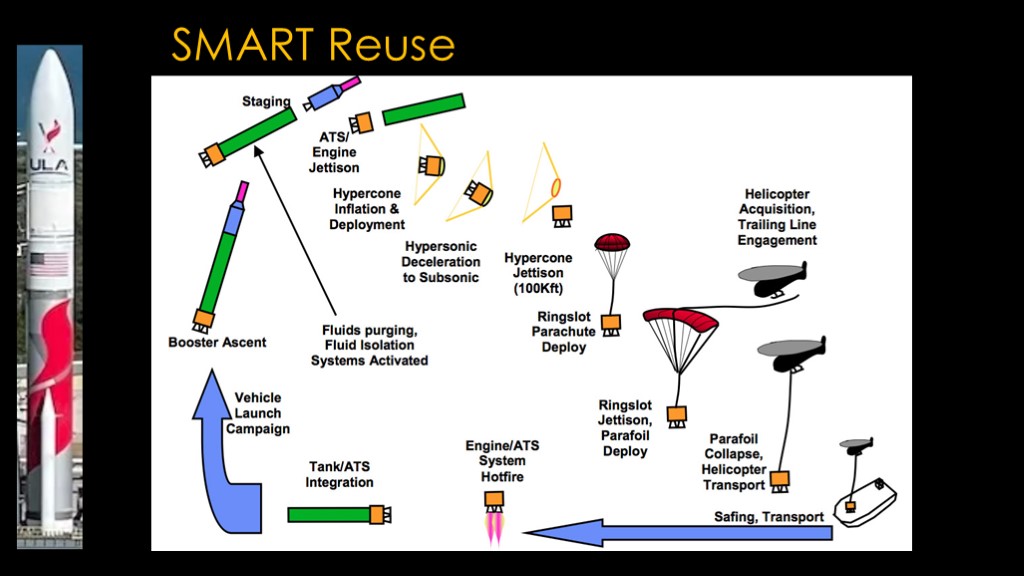
ULA has therefore defined an approach where they will separate off the expensive engine section of the booster from the rest of the booster, and it will reenter protected by an inflatable reentry vehicle using technology that has already been tested by NASA. The engine section then opens parachutes and is caught by a helicopter and dropped onto a ship to be sent back.
This is pretty much the only reuse architecture that could work for the Vulcan booster - it can't make it through reentry and even if it could, it can't propulsively land with only two engines

The pros:
They reuse the expensive engines and avionics.
They get to use a lighter and less capable second stage.
They don't need a big drone ship for landings.
They could probably fit multiple engine sections on one ship so it would take fewer trips.
The cons:
They still need some marine assets
Helicopter transport puts humans at risk and was tried and abandoned with Rocketlab's electron
They throw away the airframe and solid rocket boosters for every flight.
Their refurbishment/test/integrate cycle is a lot more complex than the current Falcon 9 flow.
It's an interesting approach. Supposedly the BE-4 engines that they buy from Blue Origin are $6-8 million each, so $12-$16 million per flight. That seems like a pretty good savings but the recovery and refurbishment costs are going to reduce that quite a bit. Ultimately, I think Vulcan has a hard time competing not because of their architecture but because they buy engines and that means their engine costs are likely to be higher than the companies that make their engines.
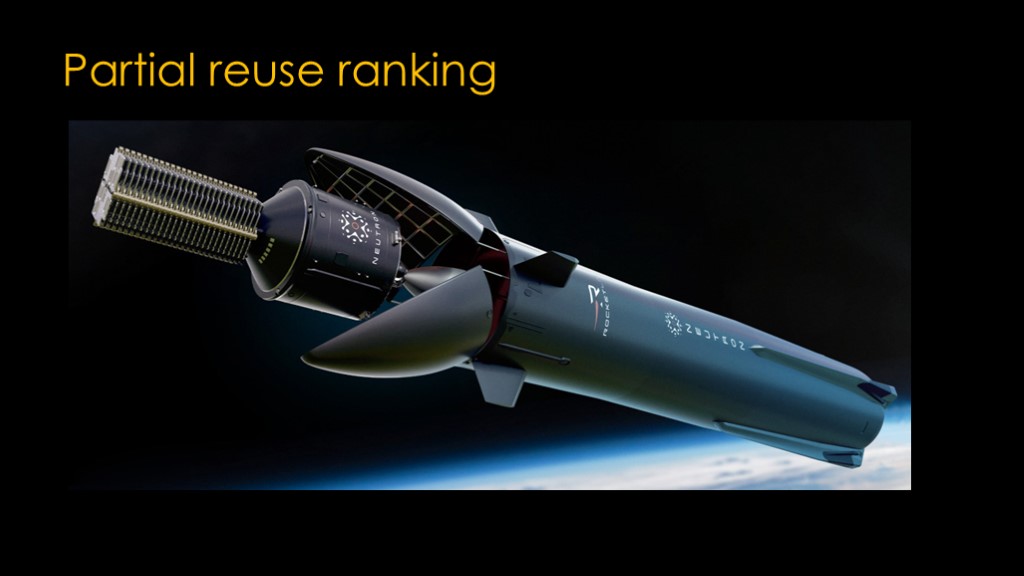
Neutron seems to be the only partially reusable rocket that has been designed from first principles, and there's a pretty good chance that it will be cheaper than Falcon 9 at a sufficiently high enough flight rate.
This seems like a good time for a break...

Choose wisely...
Like and subscribe, or
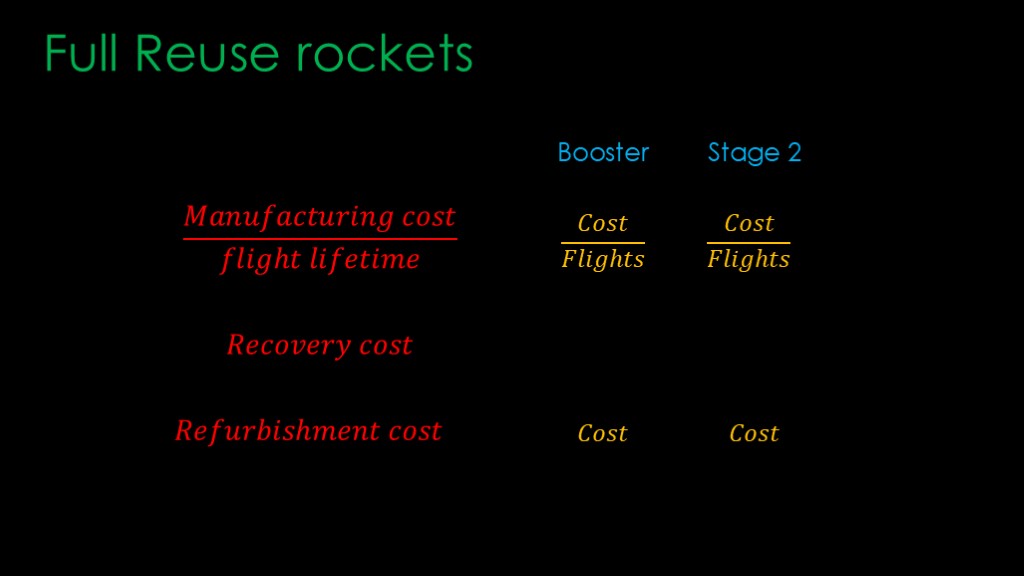
Full reuse changes the model
Both the booster and second stage will allocate the manufacturing cost across multiple flights, and both will have refurbishment costs.
Recovery costs are a bit more complex.
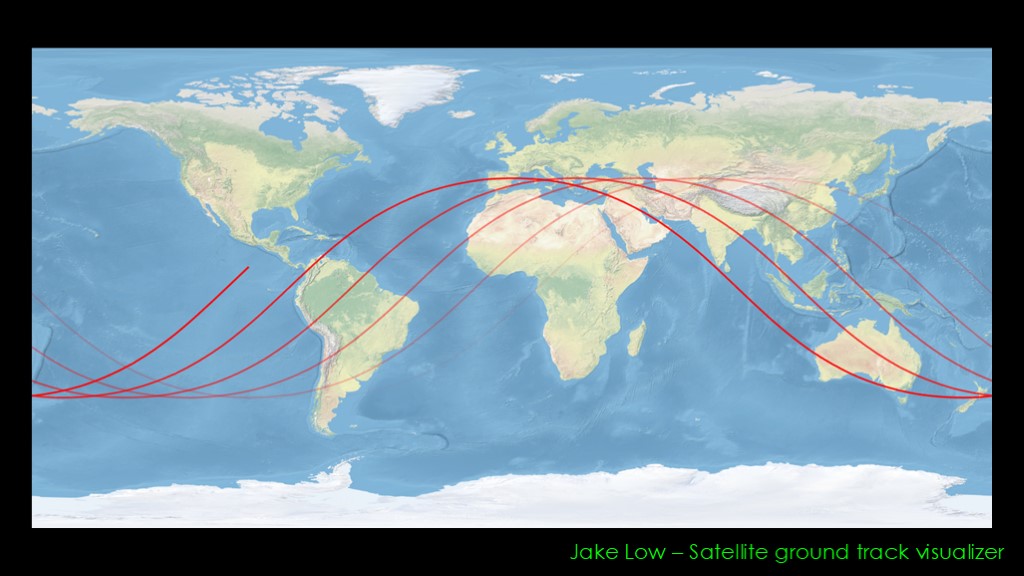
For the second stage, being in orbit is a huge advantage.
Because the earth is rotating to the east under the satellite, the ground path of the satellite moves westerly with every orbit, so you can merely wait until the satellite ground track is passing over your landing site and choose that orbit for reentry. That happens roughly twice a day for low earth orbits, with one when the vehicle is moving towards the north and one when it is moving towards the south, though the ground track over land may make one of those directions less practical.
That means that we don't have to consider drone ship landings for our second stage; it can land on land in a convenient location.
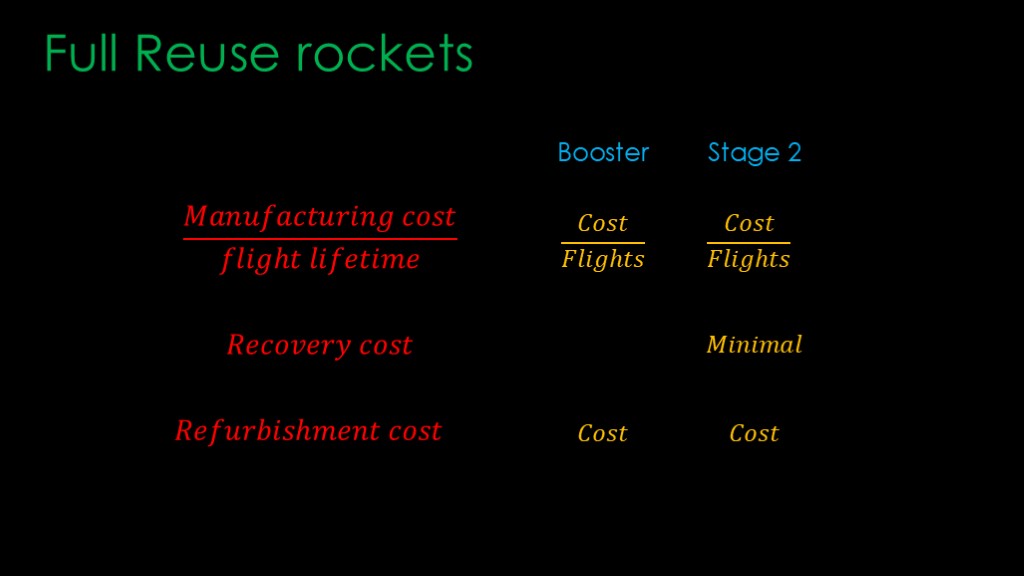
I've therefore labelled the second stage recovery cost as minimal, which is the same thing we said for the shuttle orbiter.
Which leaves us with the recovery cost for boosters. And that gets a little complicated, because there are two options.
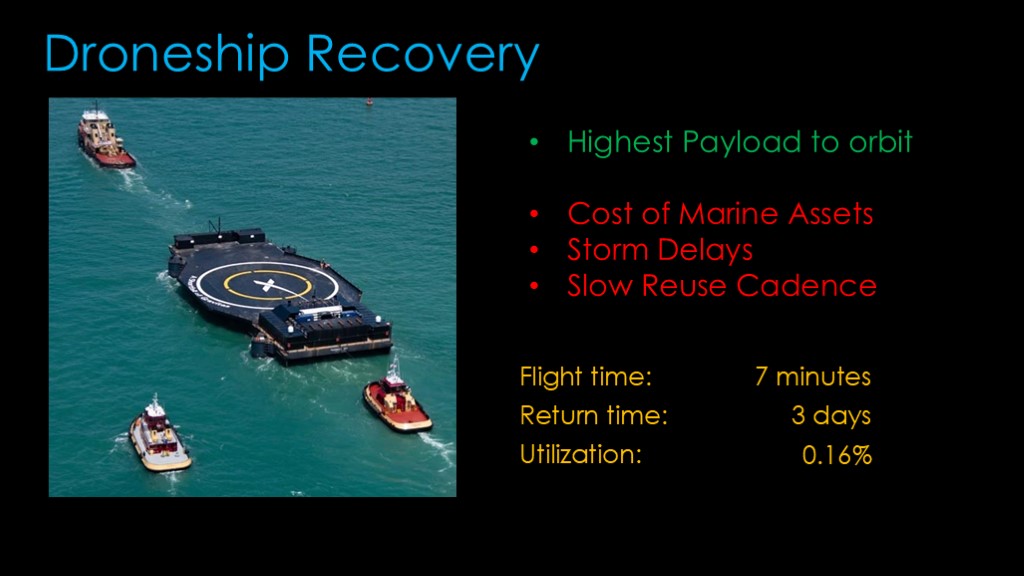
It's possible to use the droneship approach that Falcon 9 uses. That gets you the highest payload to orbit as you don't spend propellant flying back to the launch side, but you have to deal with the cost of the marine assets, the storm delays, and the slow reuse cadence.
The super Heavy booster spent about 7 minutes in the air on flight 5. If you land it on a drone ship, it will take about 3 days to get it back to the launch site.
In the drone ship scenario, the super heavy booster would spend 0.16% of its life in the air and the rest of the time on a barge at sea. That's better than throwing away the booster, but not very good in terms of utilization.

If you want a deeper discussion of this topic, see my video on starship booster droneship catching...
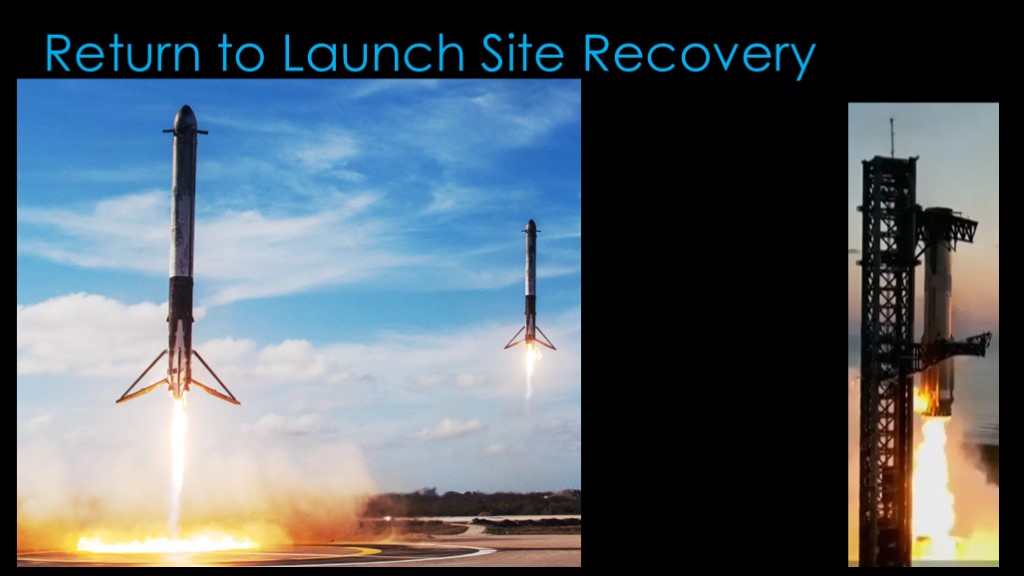
The alternative is of course the return to launch site approach that is sometimes used for Falcon 9 but will be the default approach used by Super Heavy.
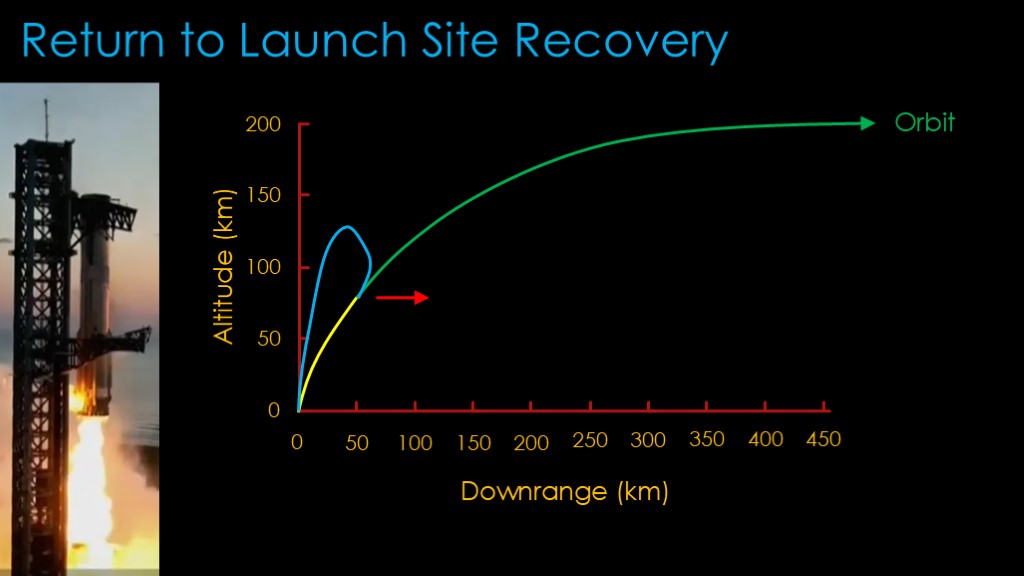
With starship, we launch the super heavy booster and it flies to about 50 miles downrange. At this point the booster and second stage are travelling downrange pretty quickly - the whole point of the rocket is to accelerate to orbital velocity.
We stage, and the second stage goes off to orbit.
For the booster, we need to get rid of that horizontal velocity and fly back to the launch site. The propellant that is used to do that can't be used to put payload into orbit, and that's the payload tax we pay to use the return to launch site approach.
To minimize the payload loss, we want to make the second stage do as much of the work as possible, which is exactly the opposite of what we wanted to do with an expended second stage.
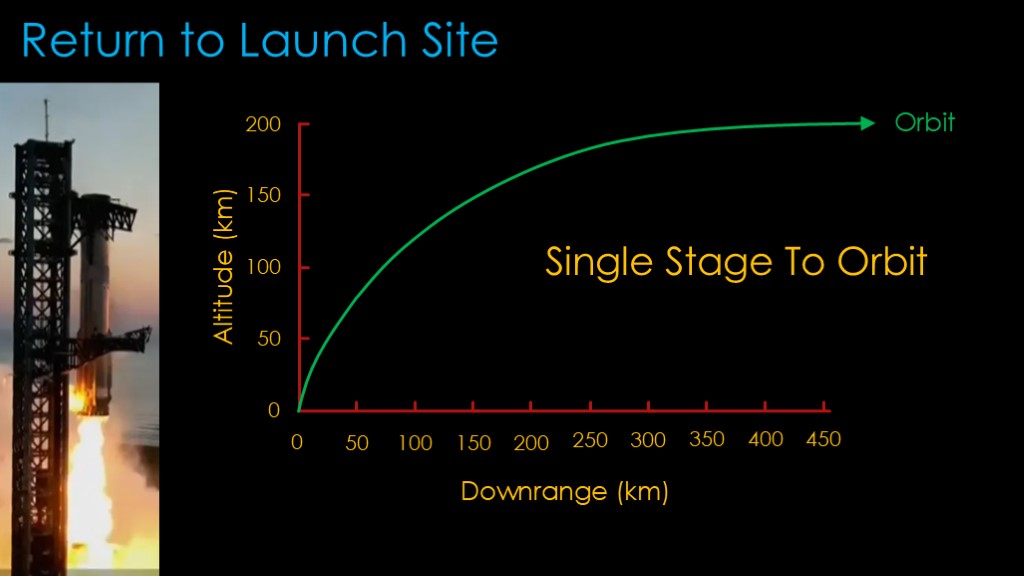
The obvious way to do that is to eliminate the booster entirely, but that would be a single stage to orbit design and those aren't actually practical, at least not practical enough for anybody to be able to build one.
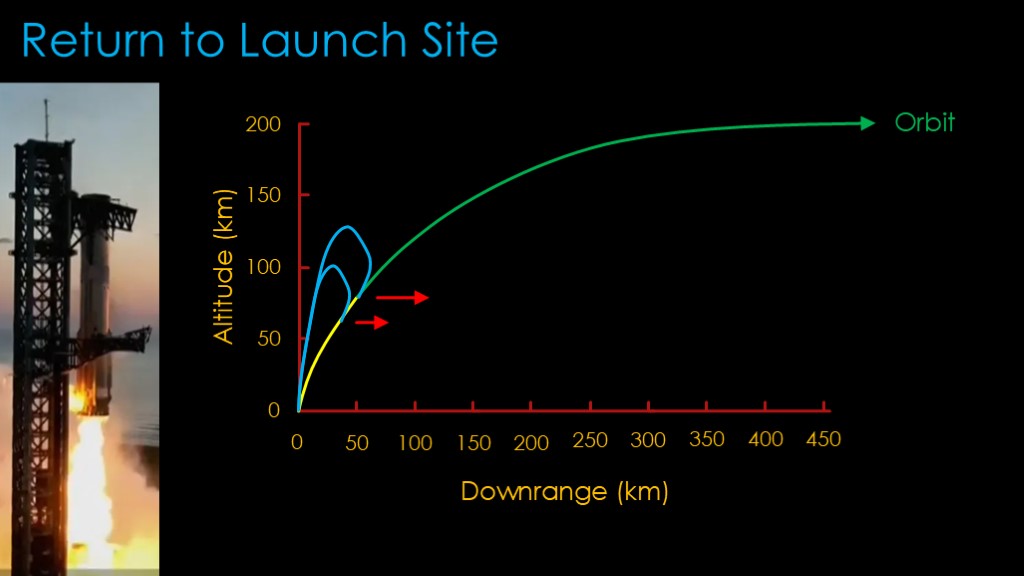
What we actually do is change our design so that we can stage a little earlier, and we do that by pushing more of the work onto the second stage. How much of the work?
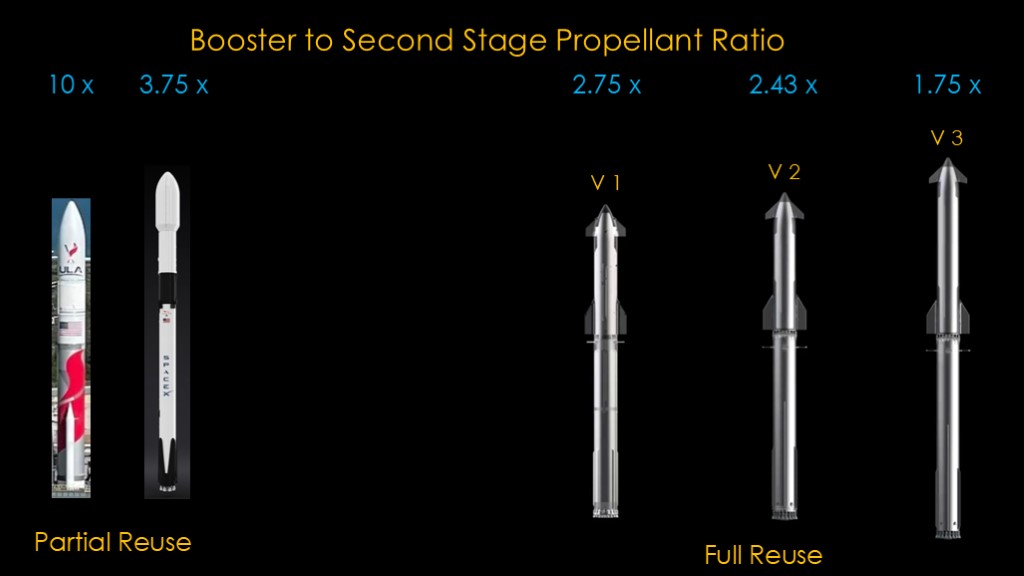
In the partial use scenario, we tried to minimize the cost and capability of the second stage because we wanted to put as little money as possible into the part we threw away. That shows up in the amount of propellant each stage carries.
For Vulcan, the booster carries about 10 times the propellant that the second stage carries, and that's ignoring the solid rocket boosters. This is not a surprise as Vulcan stages very late.
Falcon 9 comes in at about 3.75 x. The Falcon 9 second stage is very capable.
What do we get for starship?
The current version 1 starship has a ratio of only 2.75 x. It pushes much more of the work on the second stage than Falcon 9.
This continues with the version 2 starship, which reduces the ratio to 2.43 x, and the version 3 starship, which reduces it all the way down to 1.75 x.
How much will that affect staging time?

Nicely, we have the continual information leak that is Elon Musk, and we have the following information about the three starship variants (versions? Blocks? I'm not sure what to call them)
What we want to know is when we can expect booster staging.
We can calculate the rate at which propellant is burned - known as the mass flow rate - for each scenario, which is equal to the thrust in newtons divided by the specific impulse time the acceleration due to gravity, or 9.81. The specific impulse of the raptor engines used by starship is about 327 at sea level.
That gives us these numbers measured in tons of propellant per second. Divide the total propellant load by the mass flow rate, and you get the burn time.
What we find is that the booster has enough fuel for 151 seconds for version 1, 145 seconds for variant 2, and 132 seconds for block 3.
These numbers assume that the booster runs at full thrust the whole time (it doesn't) and that it doesn't reserve fuel for the return to launch site (it does), but the ratio is still interesting - the booster burn time is about 13% less for the block 3 booster.
I describe this as "as close to a single stage to orbit second stage as practical".
Starship is optimized with full reuse in mind and that makes it a weird rocket.
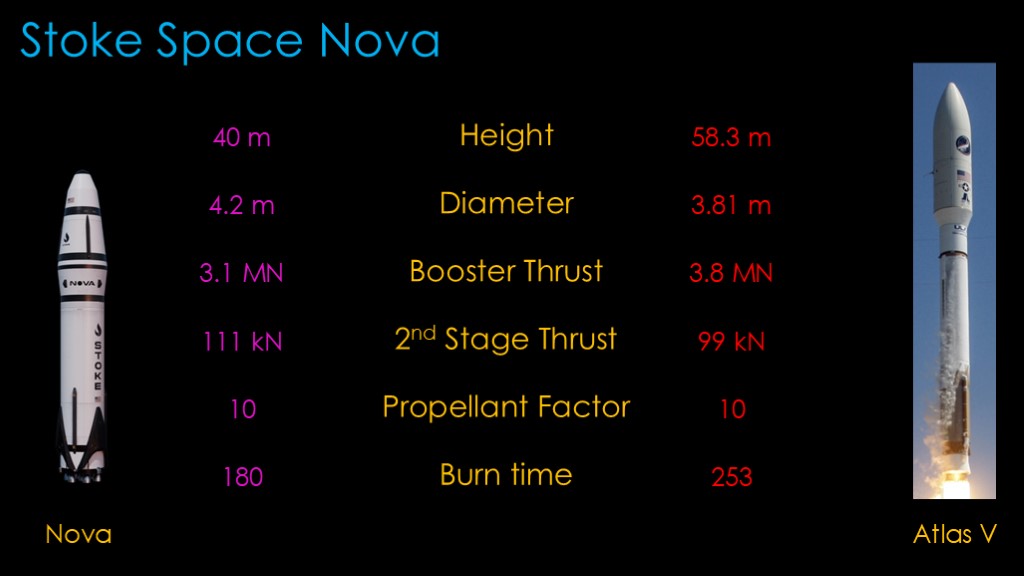
Onto Stoke space, which is making an even weirder rocket.
Stoke has become more interesting to analyze with the release of some details in their draft environmental impact statement.
Comparing it to Starship doesn't make a lot of sense as Starship is a giant, and I thought it would be more interesting to compare it to Atlas V for reasons that I hope will become obvious...
The stoke nova rocket is 40 meters high and 4.2 meters wide, making it a little shorter than Atlas V and just a little bigger around. Note that we've already run into a problem. The Nova image I'm using came from their website and I've scaled it to be about the right height compared to the Atlas V. At 4.2 meters it should be about 10% wider than the Atlas V, but based on the image it is at least 5.4 meters in diameter. It's not uncommon to find bad numbers online.
The thrust of the booster is 3.1 meganewtons for nova, 3.8 meganewtons for Atlas V. The second stage thrust is 111 kilonewtons for Nova, 99 kilonewtons for Atlas V.
If we look at the propellant factor for both rockets, we find that the booster has about 10 times the propellant of the second stage for both.
Remarkably similar rockets.
Because the RL-10 engine in the centaur upper stage is relatively low thrust, the booster of the Atlas V burns a long time - about 253 seconds - to give the upper stage a big push, and it gives it an even bigger push when solid rocket boosters are added.
The Stoke booster only has fuel to burn for 180 seconds at full throttle, and some of that fuel needs to be used for the boostback burn and landing, and that likely puts it down to 160-170 seconds before staging, roughly what Falcon 9 does.
That means the second stage has to do about as much work as the Falcon 9 second stage does but do it with much less thrust, much less delta-v, and a requirement to reserve fuel to come back to earth and land.
That doesn't seem possible with any useful payload, and pretty clearly Stoke is planning on carrying payload, so that means that numbers are wrong or I'm missing something, or both.
The stoke "information" is great to see but it raises more questions than it answers. I can't evaluate their approach without information that makes sense, so you'll have to settle for my subjective opinion.
I like that Stoke is trying something different. Their approach is possible, it's not clear that it's practical, and even if it's practical, it may not be economical. It's possible that they end up with a fully-reusable solution but it turns out that Neutron is cheaper because their second stage is so cheap.
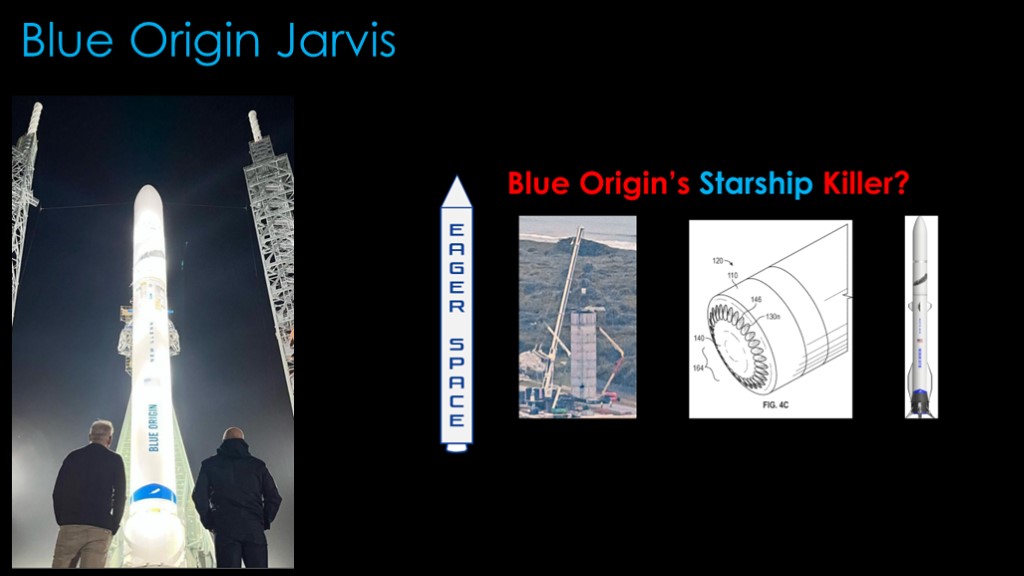
I was hoping to be able to talk about Blue Origin's Project Jarvis, a reusable upper stage for their New Glenn rocket, but Blue Origin has released very little information.
According to a 2024 interview with Jeff Bezos, Blue hasn't decided whether a fully-reusable vehicle makes sense, and that when you look at the trades - or tradeoffs - it isn't obvious which way to go.
This seems to be a case of Blue focusing on getting New Glenn flying first and putting off a possible project for full reusability later, which would be an admirable choice given Blue's general proclivity to try to do everything at once.
I did a video on project Jarvis that speculates about what a reusable second stage might look like. Note the word "speculates".
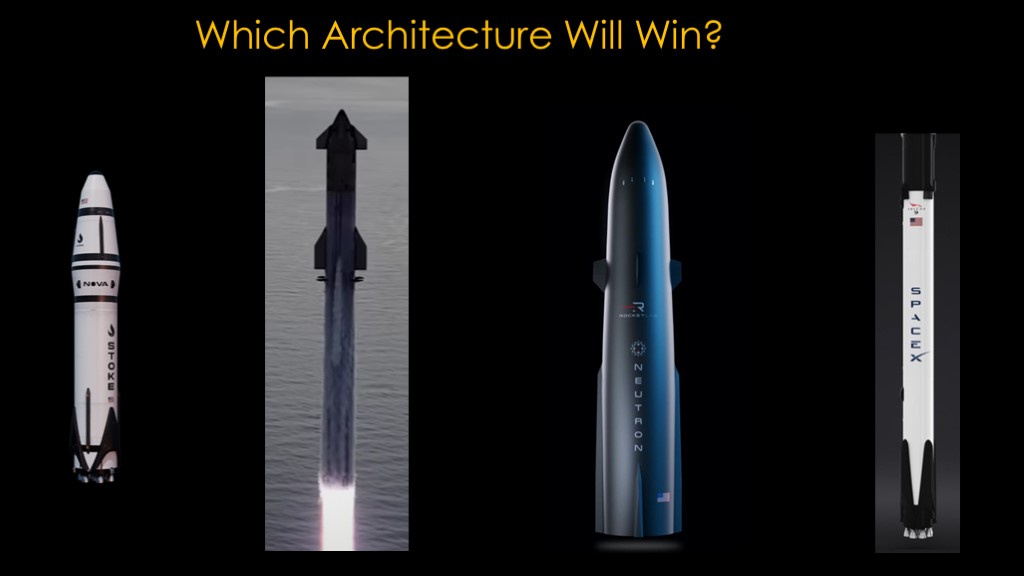
Which architecture will win?
Falcon 9 is obviously the current benchmark and has some big advantages because of their high flight rate, but I suspect that Neutron is going to be pretty busy, because I think the Neutron architecture is going to be superior for a partially reusable rocket. I think they'll both survive.
I'm not sure any of the uninteresting rockets are going to make much of a splash, though New Glenn is the dark horse because of Bezos' willingness to just throw lots of money at a project, and I expect them to survive as a partially reusable rocket but not really compete because of their corporate culture.
For fully reusable, Starship is clearly ahead and with their sixth flight looming - if I get this video released early enough - and I expect they will end up with a functional launcher. I'm still not sure about Stoke, but they are clearly the second place team right now and I think they market can use a smaller rocket than Starship.
And that's my evaluation of the different reusable rockets that may show up in the next little while.

If you liked this video, be like me and buy a copy of this wonderful image of a sloth in a spacesuit hanging from the rings of Saturn to hang on your wall.
See the video description for a link to the Etsy store named WildTypeVisions...

If you like my videos, you may like the new EagerSpace.net website which contains the script for all the videos, along with ways to support the channel or connect with me.